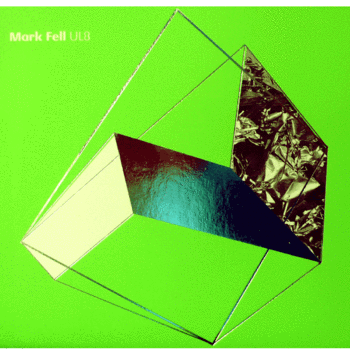
EMEGO 111 / Mark Fell
UL8
- 1. Part 1: The Occultation of 3C 273 - 1 (5:37)
- 2. Part 1: The Occultation of 3C 273 - 2 (7:26)
- 3. Part 1: The Occultation of 3C 273 - 3 (3:05)
- 4. Part 1: The Occultation of 3C 273 - 4 (1:51)
- 5. Part 1: The Occultation of 3C 273 - 5 (3:11)
- 6. Part 2: Vortex Studies - 1 (8:00)
- 7. Part 2: Vortex Studies - 2 (2:39)
- 8. Part 2: Vortex Studies - 3 (3:42)
- 9. Part 2: Vortex Studies - 4 (1:22)
- 10. Part 2: Vortex Studies - 5 (2:53)
- 11. Part 2: Vortex Studies - 6 (0:33)
- 12. Part 2: Vortex Studies - 7 (3:39)
- 13. Part 3: Acids In The Style of Rian Treanor - 1 (1:06)
- 14. Part 3: Acids In The Style of Rian Treanor - 2 (2:06)
- 15. Part 3: Acids In The Style of Rian Treanor - 3 (2:44)
- 16. Part 3: Acids In The Style of Rian Treanor - 4 (2:30)
- 17. Part 3: Acids In The Style of Rian Treanor - 5 (2:03)
- 18. Part 3: Acids In The Style of Rian Treanor - 6 (1:56)
- 19. Part 3: Acids In The Style of Rian Treanor - 7 (5:06)
- 20. Death of Loved One (3:34)
Buy
SECOND EDITION NOW AVAILABLE IN GREEN
Written and recorded in Whitby, York and Rotherham (UK) during summer 2010 by Mark Fell.
Mastered at Dubplates and Mastering Berlin in 2010 by Lupo.
Packaged in 4 panel dgipack with day-glow orange (1st pressing) and green (2nd pressing) with silver foil print
"Middle sized member of the UL range, the UL8, a three unit system, embodies the good looks and high performance associated with Celestion designed products. Utilising the HD1000 pressured dome tweeter and an 8 inch mid/bass driver, which together a similar sized A.B.R. combine to give an overall frequency response of 30 Hz to 28 kHz. The mid/bass drivers large magnet system perfectly controls the excursions of the specially processed Bextrene cone assembly with its 1.5 inch voice coil. Designed to a precise specification, the UL8 achieves highly realistic ‘music’ reproduction."
quoted from
http://mycolectionditton.com/DittonUL8.html
This project takes its name from the Celestion UL8 speaker. My older brother bought a pair of these when i was starting comprehensive school, and between his 10cc and Supertramp records i first encountered electronically synthesized sound at high volumes. I soon noticed a pattern emerging in my musical tastes which excluded guitars or drums. Instead i favoured almost exclusively the electronic textures and rhythms of The Human League, Fad Gadget and other synthesiser based music of that period. I was quite curious about this prejudice and would try to work out why Kraftwerk sounded so much better than a rock band of the time.
So began my interest in the texture of synthetic sound - there was something much more beautiful (and perhaps more emotionally charged) about a sustained square wave than any guitar solo. I began search out and replay sections of music which dropped to a single sound - these, for some reason, were the best. This interest increased when, a few months later, my parent's next door neighbour (a technician in the electronics department at Sheffield University) let me borrow his analogue synthesiser on semi-permanent loan. And, following that, i managed to convince my dad to buy me a cheap second hand Boss Dr55 drum machine.
Many years later Mat Steel and i used the UL8 speakers, now relegated to an attic in a rented house, to work on early abandoned 12" projects (circa 1993). Finally my brother gave in to demand and let me have the speakers which now sit in my front room. Although these are of little use in a studio context, they still provide an adequate and often rewarding listening experience. The tracks here replicate the simple monosynth and drum machine equation; and have, to a large extent, been made with and for the UL8.
Part 1: The Occultation of 3C 273
Using 32 operator frequency modulation synthesis configured in 16 pairs of operator and modulator. Frequency, modulation ratio and amount determined by linear interpolation between two spatial extremes, with further interpolation over variable temporal divisions. Panned at equal positions around the circumference of a circle using high order ambisonics. First implemented for the DVD ‘Attack on Silence’ (Line Records 2008) and developed for the cassette release ‘Thunder Bollocks’ with Evol (Alku 2009). The compositions here also feature modified Roland TR707 and Linn kick drum samples.
Tracks 1 to 5; durations 5:37, 7:26, 3:05, 1:51 and 3:11.
Part 2: Vortex Studies
With 2, 4 or 8 channel rectangular waveforms with variable pulse width subject to frequency modulation from syncronised sine functions with variable phase offsets. Initally implemented with syncronised blue light at Algorithm, Glade (Thatcham 2008) with further presentations at Enjoy (Leeds 2008), Centre d’Art Santa Mònica, Sonar (Barcelona 2008), Three Pieces For Unattended, Somewhat Attended and Attended Computer (Sheffield 2008), Avoid (Leeds 2009), Three Neurocognitive Approaches To The Formation Of Cross-Modal Objecthood (Rotherham 2009) Sonic Materialities (Sheffield 2010) and as Supersymmetry at Matter-Space-Motion (Elsecar 2010). Here with percussion synthesis.
Tracks 6 to 12; durations 8:00, 2:39, 3:42, 1:22, 12:53, 0:33 and 3:39.
Part 3: Acids In The Style of Rian Treanor
Tracks 13 to 19; durations 1:06, 2:06, 2:44, 2:30, 2:03, 1:56 and 5:06.
And Track 20 Death of Loved One 3:34
Total Running Time 1:04:51.
